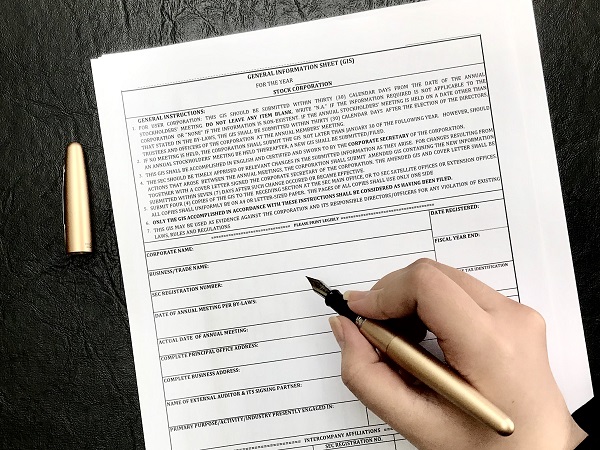
By: Maria Concepcion P. Simundac and Winona Maraiah M. Fajardo
In November 2018, the Securities and Exchange Commission (SEC) issued a memorandum revising the General Information Sheet (GIS) form, requiring the submission of beneficial ownership information in the annual GIS. The SEC sought to implement the Anti-Money Laundering Act (AMLA) and the Terrorist Financing Prevention and Suppression Act (TFPSA) through the new measure. However, implementation of the amended form was deferred.
Last July 26, 2019, the SEC issued Memorandum Circular No. 15, Series of 2019 amending the form of the GIS to now include the declaration of beneficial ownership information. Effective July 31, 2019, every stock or non-stock domestic corporation must submit a breakdown of the persons who “ultimately own or control, or exercise ultimate effective control” over the corporation.
Listed below are the salient developments of the new GIS form:
Identifying the Beneficial Owners
There are three ways for a person to be considered beneficial owner: First, a person, directly or indirectly, or through a chain of ownership, owns at least twenty-five percent (25%) of voting rights or capital. This mode extends to estates, trusts or partnerships, with the natural person owning or controlling the estate, trust or partnership, deemed as the beneficial owner in the GIS.
Second is when a natural person exercises control of the corporation through other means. This includes persons whose directions, instruction or wishes in conducting the affairs of the corporation are carried out by majority of the members of the board or have the ability to exert a dominant influence over the management or policies of the corporation. This may also manifest in a person’s ability to elect a majority of the board of the reporting corporation.
Lastly, in exceptional cases wherein no natural person can be identified as the one ultimately owning or controlling, or exercising ultimate effective control through ownership interest, voting rights, or other means, the natural persons composing the board of directors or trustees, a similar body exercising the same functions, and/or the senior managing official of the reporting corporation, such as the CEO or President, will be considered as having beneficial ownership of the corporation. However, the reporting corporation must demonstrate that it exhausted all possible means of identifying the beneficial owner. Sanctions may be imposed by the SEC if, upon verification and monitoring, it shall appear otherwise.
Grandfather Rule to Determine Indirect Ownership
Generally, the Grandfather Rule is used to determine the percentage of Filipino ownership in a corporation engaged in nationalized and/or partly nationalized activities, as provided in the Constitution and other laws. The nationality of the second or subsequent layer of ownership is examined to ascertain the actual nationality of the corporate shareholder.
In this instance, the Grandfather Rule shall be applied for a limited purpose, such that the actual percentage of beneficial ownership shall be verified by identifying both the direct and indirect shareholdings of the corporation. The Circular requires a disclosure of all intermediate layers of corporate shareholders and prescribes the use of the Grandfather Rule methodology to show the real ownership structure of the reporting corporation.
Due Diligence Obligations
Within seven (7) working days after any relevant changes in the beneficial ownership of a corporation, an updated GIS must be submitted to the SEC. In the event the corporation fails to submit an updated GIS within that period, it shall have thirty (30) working days from occurrence or effectivity of the change to provide an explanation for failure to submit.
The Directors/Trustees and Officers of the corporation must exercise due diligence to ensure that the disclosure of beneficial ownership in the GIS is made. The Circular provides that this due diligence requirement is deemed complied with if:
-
Reasonable measures are undertaken to obtain and hold updated information on the beneficial owners; and
-
Timely disclosure of beneficial ownership information in the GIS is ensured.
Reasonable measures consist of adoption of policies and procedures to obtain, update and record beneficial ownership information. It is also required that the board and senior management establish safeguards for the observance of these procedures.
Information Validation
The SEC is also empowered to verify the beneficial ownership information provided in the GIS by means of an on-site inspection of the books and records of the corporation. It can also make use of other means available, including information gathered from the books and records of other corporate entities, or data obtained by law enforcement agencies, the Anti-Money Laundering Council (AMLC) and other government agencies.
Penalties for Directors and Corporations
In the event of failure to disclose beneficial ownership without lawful cause, both the corporation itself and the individual directors/trustees or officers are penalized under the Circular.
For corporations, the penalty largely depends on the amount of retained earnings or fund balance for stock or non-stock corporations, respectively. As the thresholds increase, the penalties imposed also rise to as much as four times the prescribed penalty. Heavier impositions are made for subsequent violations.
Meanwhile, should the SEC learn that the directors/trustees and/or officers, including the Corporate Secretary, failed to exercise the appropriate due diligence to guarantee compliance with the obligation to disclose beneficial ownership information, a penalty ranging from PhP5,000.00 to PhP50,000.00 would be imposed upon said individuals.
Likewise, the following acts are considered prima facie proof of the failure to exercise due diligence required of directors/trustees and/or officers of the corporation:
-
Absence of written procedures and policies for obtaining, updating and recording beneficial ownership information;
-
Submission of GIS without the required beneficial ownership information;
-
Late submission of the GIS;
-
Lack of Board or senior management oversight to ensure compliance with said policies and procedures; and
-
Failure to timely disclose beneficial ownership information to the SEC.
The above article is for information purposes only and is not intended to constitute legal advice.

